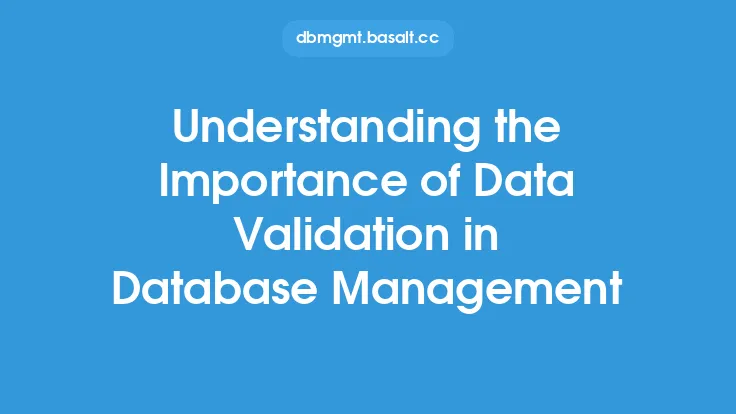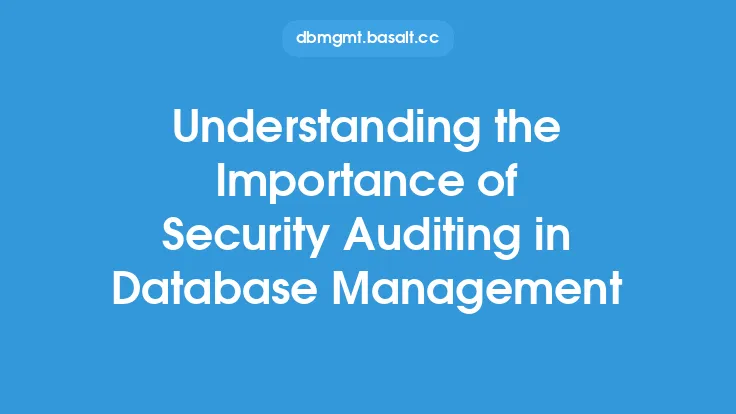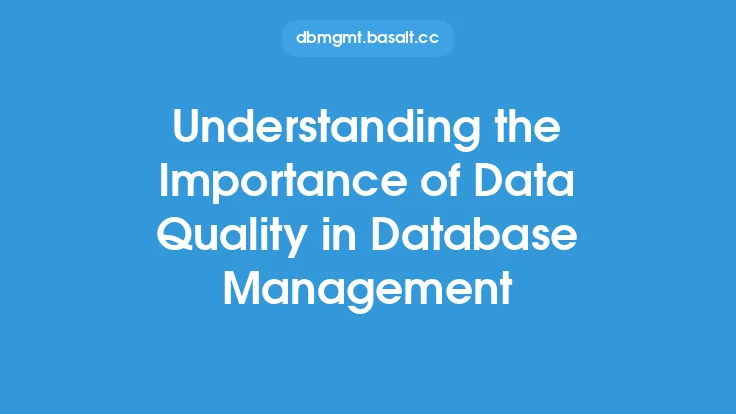Data archiving is a critical component of database management that involves the systematic removal and storage of inactive or infrequently accessed data from a database. This process is essential for maintaining the performance, scalability, and cost-effectiveness of a database. By archiving data, organizations can reduce the amount of data stored in their primary databases, which can lead to improved query performance, reduced storage costs, and enhanced data management.
Introduction to Data Archiving
Data archiving is a process that involves the identification, classification, and migration of inactive or infrequently accessed data to a separate storage location. This process is typically automated and can be performed on a scheduled basis. The archived data is stored in a compressed and encrypted format to ensure its integrity and security. Data archiving is not the same as data backup, although the two terms are often used interchangeably. Data backup involves creating a copy of the entire database, whereas data archiving involves removing and storing inactive data.
Benefits of Data Archiving
The benefits of data archiving are numerous and can have a significant impact on an organization's database management strategy. Some of the key benefits of data archiving include:
- Improved database performance: By removing inactive data from the primary database, query performance can be improved, and the overall responsiveness of the database can be enhanced.
- Reduced storage costs: Data archiving can help reduce the amount of data stored in the primary database, which can lead to lower storage costs and improved cost-effectiveness.
- Enhanced data management: Data archiving can help organizations manage their data more effectively by providing a systematic approach to data removal and storage.
- Improved data security: Data archiving can help improve data security by removing sensitive data from the primary database and storing it in a secure, encrypted format.
- Compliance with regulatory requirements: Data archiving can help organizations comply with regulatory requirements by providing a secure and auditable storage solution for sensitive data.
Importance of Data Archiving in Database Management
Data archiving is an essential component of database management, and its importance cannot be overstated. Some of the key reasons why data archiving is important in database management include:
- Database performance: As databases grow in size, their performance can degrade, leading to slower query times and reduced responsiveness. Data archiving can help improve database performance by removing inactive data and reducing the overall size of the database.
- Data growth: Data growth is a significant challenge in database management, and data archiving can help organizations manage this growth by providing a systematic approach to data removal and storage.
- Cost savings: Data archiving can help organizations reduce their storage costs by removing inactive data from the primary database and storing it in a lower-cost storage solution.
- Data security: Data archiving can help improve data security by removing sensitive data from the primary database and storing it in a secure, encrypted format.
Data Archiving Methods
There are several data archiving methods that organizations can use, including:
- Online archiving: This method involves storing archived data online, where it can be accessed quickly and easily.
- Nearline archiving: This method involves storing archived data nearline, where it can be accessed quickly, but not as quickly as online data.
- Offline archiving: This method involves storing archived data offline, where it can be accessed, but not as quickly as online or nearline data.
- Hierarchical storage management (HSM): This method involves storing data on a hierarchy of storage devices, with the most frequently accessed data stored on the fastest devices.
Data Archiving Tools and Technologies
There are several data archiving tools and technologies that organizations can use to implement a data archiving strategy. Some of the key tools and technologies include:
- Data archiving software: This software provides a systematic approach to data archiving and can be used to automate the archiving process.
- Storage devices: There are several storage devices that can be used for data archiving, including hard disk drives, solid-state drives, and tape drives.
- Cloud storage: Cloud storage provides a scalable and cost-effective storage solution for archived data.
- Data compression and encryption tools: These tools can be used to compress and encrypt archived data, ensuring its integrity and security.
Best Practices for Data Archiving
There are several best practices that organizations can follow to ensure effective data archiving. Some of the key best practices include:
- Develop a data archiving strategy: Organizations should develop a data archiving strategy that aligns with their business goals and objectives.
- Identify and classify data: Organizations should identify and classify their data to determine which data should be archived and which data should be retained in the primary database.
- Automate the archiving process: Organizations should automate the archiving process to ensure that it is performed consistently and efficiently.
- Monitor and maintain archived data: Organizations should monitor and maintain their archived data to ensure its integrity and security.
Conclusion
Data archiving is a critical component of database management that involves the systematic removal and storage of inactive or infrequently accessed data from a database. The benefits of data archiving are numerous and can have a significant impact on an organization's database management strategy. By understanding the importance of data archiving and implementing a data archiving strategy, organizations can improve database performance, reduce storage costs, and enhance data management.





